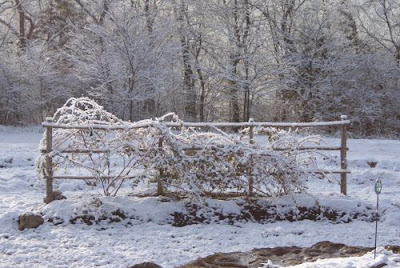It's that time of year again. I'm thinking about seeds, seeds, seeds.
Seeds are incredibly amazing beings. Each seed, no matter how tiny, is a miniature plant curled up inside a protective shell. Each seed has a tiny root (radicle), a stem (hypocotyl), and miniature seed leaves (cotyledons).
At left is a little drawing I did of the interior structure of a seed. The green part is the cotyledons, seed leaves, that contain food to nourish the little seedling once the seed coat cracks.
Although the seed appears to be sleeping, lots of enzymatic and chemical actions take place to prepare the seed to germinate and grow.
No matter how tiny the seed is, it contains the same structure and processes as much larger seeds, like that avocado pit you just tossed into the compost bucket.
The seed waits for the right conditions -- the proper amount of moisture absorbed, the appropriate soil temperature, and who knows what else the seed is waiting for that will disintegrate the germination inhibitors that all seeds contain. All seeds and/or the fruits they form within, contain germination inhibitors, otherwise they might germinate at a time or place the seedling cannot survive. When the germination inhibitors are gone, the radicle is the first to emerge, digging into the soil. Then the little seed leaves unfurl, soaking up sunlight. And you have a plant.
The photo at the top of this post is of the refrigerator drawer where I store my seeds. When stored in proper conditions seeds can remain viable for quite some time. Just how long seeds remain alive depends on what plant they come from. Melon seeds, for example, remain viable for much longer that seeds of leeks and onions. So I can stock up several years worth of melon seed, but only a couple of years' worth of leek and onion seeds. However, seeds will survive past the expected life expectancy when stored properly. According to "The Seed Garden," published by the Seed Savers Exchange, okra seeds have a life expectancy of just two to three years. Yet I had 10-year-old okra seeds germinate almost 100 percent. Then we have ancient varieties of beans and squash that germinated after thousands of years in buried clay pots. Some of these, such as the "Cave Bean" featured in Baker Creek Heirloom Seeds catalog, have been propagated and shared, reviving those old varieties.
None of the seeds in my refrigerator drawer are thousands of years old, or even 10 years old, but some are six or seven years old.
Tonight I started germination tests on some of the older seed so I know whether I need to replace it, or whether I can plant it for another season. A germination test is pretty simple. Basically, you need water, a paper towel, and seeds. Here are step-by-step instructions and pictures on a blog post I wrote for our Extension Master Gardeners' Web site.
Not all of my seeds are those I've purchased. For a number of years I've saved seeds from cultivated flowers, like poppies, and some wildflowers. I pretty much stick to those that are easy to gather, like poppies and celosia, or columbines and royal catchfly.
At right are some of the seeds in this year's collection, Royal Catchfly, Clammy Weed, two kinds of celosia, and something I can't identify in this photo.
At some point I will shake the seeds loose from their pods and capsules and store them in much smaller containers for planting and sharing later. For now, however, they are in bags, buckets and other containers in the garage. I have only a little more than a month to do this if I want to take any to the local seed fair to share.
This year I hope to start saving some vegetable seeds. Those of beans and peas are pretty easy to collect and save. You just wait until the pods have dried, then separate the seed from the pods. Pepper seed also is easy to collect. The seed is mature when the peppers have ripened to their mature color, which is when I think they taste best. Spread them out to dry before putting them into storage. You don't want them moist enough to mold.
Tomatoes are trickier, as you must "ferment" the seeds in the pulp, then clean and dry them.
Saving seeds begins when you are planning where to plant things. Plants that rely on insect pollination have long "isolation distances." That is the distance you must have between different varieties of one species to avoid cross pollination. Wind pollinated plants, such as corn, also might require long isolation distances. Corn varieties, for example must be separated by 800 feet to a half mile. Self-pollinating plants, such as tomatoes, require much less distance for isolation. Tomato varieties need be only 10-50 feet apart. So it is important to find reliable information about how to plan for saving seed. "The Seed Garden" is an excellent resource, but I am certain you can find a lot online, as well.
One benefit of saving seeds is having a reliable supply that costs you nothing. If you want to put in more effort, you also can select seed only from the healthiest plants that exhibit the best desirable traits. Over the years, then you are cultivating plants better adapted to your garden's conditions, and exhibiting the traits you most desire.
Never save seed from unhealthy plants or splotchy fruits because the seeds could carry disease from one generation to the next.
I'll let you know how my seed saving goes. Let me know what your seed saving experiences are.





















